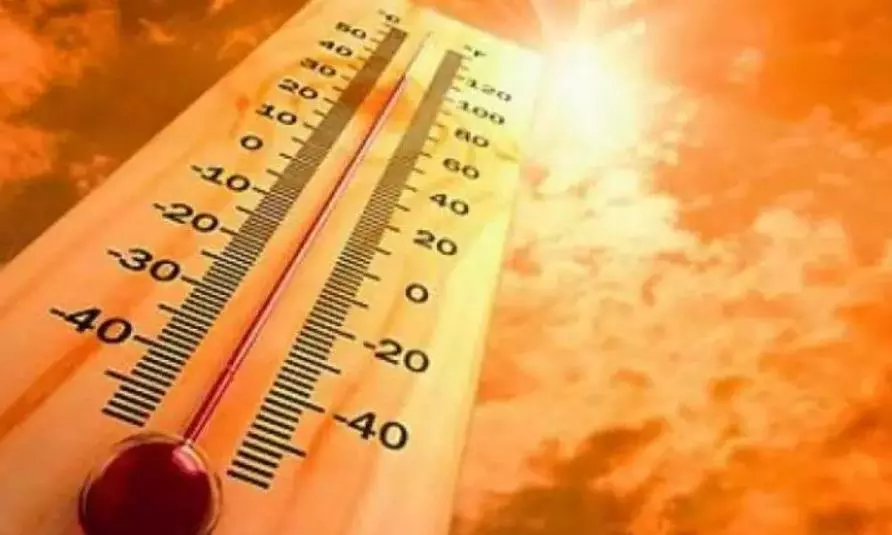Srinagar Sizzles At 37.4°C, The Highest Temperature For July Since 1953
Unprecedented high temperatures, poor precipitation threaten fruit and paddy crops

Srinagar: Kashmir Valley, particularly capital Srinagar, has been grappling with intense heatwave conditions for the past couple of weeks, with temperatures soaring to extreme levels.
On Saturday, at 37.4°C, Srinagar recorded its third highest temperature for July while premier tourist destinations Pahalgam and Kokernag touched maximum ever and second highest respectively for the month.
A meteorological department official here said that Saturday’s maximum temperature recorded in Srinagar was only two notches below the second highest (37.7°C) recorded on July 5, 953. The capital city had recorded its all- time highest maximum temperature of 38.3°C on July 10, 1946, the official said.
The temperature recorded on Saturday also stood as the third-highest July reading since 1892, reflecting the intensity of the ongoing heatwave that has gripped the region.
Pahalgam, which serves as a major base camp for ongoing Amarnath Yatra, recorded its all-time highest maximum temperature of 31.6°C, surpassing previous highest of 31.5°C on July 21, 2024.
Kokernag recorded its second highest ever maximum temperature at 34.0°C, just a notch below the highest ever temperature (34.1°C) witnessed in the south Kashmir areas on July 28, 2024.
The scenic Kashmir Valley had been renowned for its pleasant summer weather, typically from May to August. Temperatures would normally range from 15°C to 30°C (59°F to 86°F), offering a cool and comfortable escape compared to the scorching heat of the Indian plains. The ongoing heatwave has dented this image of the Valley, however.
The heatwave, part of a broader pattern linked to climate change, has been exacerbated by factors like rapid urbanization, reduction of forest cover and global warming. However, the MeT department has predicted a generally cloudy weather with possibility of intermittent light to moderate rain and thundershower at many places between July 6-8. “Few places may receive intense showers with heavy rain at isolated places of Jammu division mainly towards late night/ early morning Sunday,” it said.
It added that on July 9-10, there is possibility of light to moderate rain and thundershower at scattered to many places whereas hot and humid weather with brief showers is expected at scattered places on July 11-12.
The prolonged heatwave and dry spell have left the fruit growers anxious as it is taking a toll on the Valley’s horticulture sector, a primary source of livelihood for a major section of the population. The orchardists say that the intense sunlight without water is causing fruit fall. “The fruit peel is getting damaged and the overall quality has deteriorated. If this continues, it will reduce our income drastically,” said one of them.
Javid Ahmad, a horticulture scientist, told local news agency KNO that the soaring temperatures are stressing apple trees, particularly in areas where irrigation infrastructure is absent.
“Farmers are already reporting smaller fruit size, sunburnt apples and significant fruit fall. Lack of moisture not only reduces yield but also affects the tree's ability to bear fruit next season,” he said.
Ahmad warned that if the situation persists, it could even lead to long-term damage to the tree structure itself. “The tree’s physiological stress increases manifold, and recovery becomes difficult. This could mean long-term income loss for thousands of growers, ” he said.
Kashmir produces 20-25 lakh metric tonnes of apples annually. Officials said that 60 percent of the Valley’s orchards are rain-fed, making them highly vulnerable to dry spells. The experts say that a hit to this industry will ripple through the entire economy.
Bashir Ahmad Basheer, Chairman of the Kashmir Valley Fruit Growers Cum Dealers Union, said that poor quality and reduced size mean the fruit won’t fetch good prices in national or international markets.
“The competition is tough. We are already struggling with imported apples in Indian markets. If our fruit loses shine and size, we won't survive. This dry spell is a major concern,” he told KNO.
As annual maximum and minimum temperatures in the Valley have steadily increased at rates of approximately 0.02°C per year over the past few years, the changing condition has put the paddy farmers and those associated with agriculture too in dire straits.
The data indicates a notable temperature jump around 1996-1997, with recent decades being warmer than the earlier years analyzed. While temperatures rise, the Valley is experiencing a sharp decline in precipitation. The annual rainfall has decreased by about 5 mm per year, with the most significant drops occurring in mountainous and foothill regions—areas critical for glacier recharge and water supply. Also, seasonal rainfall has fallen markedly in spring and winter, seasons vital for maintaining glaciers and groundwater.
This reduction in rainfall threatens the perennial flow of major rivers such as the Chenab, Jhelum, and Indus, which depend on glacier melt and spring precipitation.
Farmers report that diminished snowfall and erratic rains have led to water shortages for irrigation, particularly impacting the traditional paddy (rice) cultivation during the summer Kharif season.

